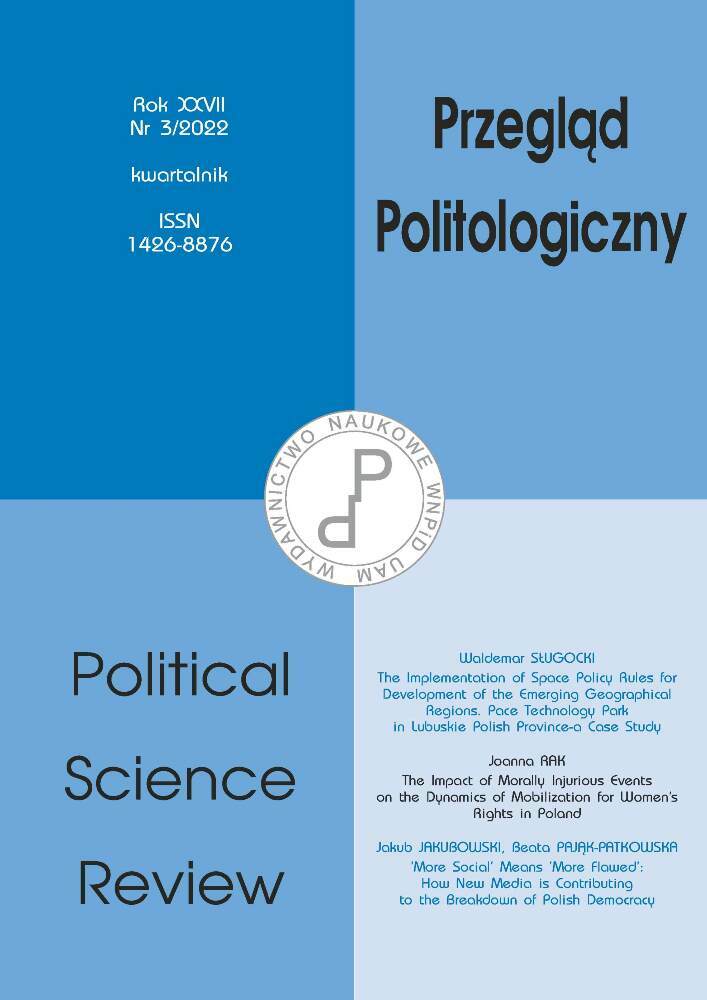Abstrakt
Opierając się na wynikach wcześniejszych badań dotyczących wpływu pandemii COVID-19 na ruch transgraniczny w Unii Europejskiej i separacji rodzin transgranicznych, w badaniu skupiono się na wpływie pandemii COVID-19 na ruch transgraniczny polskich rodzin w Unii Europejskiej, a konkretnie sytuacji polskich rodzin oddzielonych granicami pozostającymi w strefie Schengen. Badanie analizuje sposoby, dzięki którym Covid radykalnie ograniczył swobodę przemieszczania się obywateli UE w strefie Schengen, zwłaszcza między Polską a Niemcami. Korzystanie z metod badawczych, takich jak przegląd literatury, obserwacja uczestnicząca i wywiad umożliwiło identyfikacje kluczowych czynników, które ukształtowały kryzys migracyjny podczas pandemii COVID-19 w strefie Schengen, a następnie pozwoliło skupić się na bardziej szczegółowym badaniu dojazdów i problemów migracyjnych polskich rodzin transgranicznych. W artykule sformułowano hipotezę, że polskie rodziny przygraniczne zostały znacząco dotknięte ograniczeniami ruchu granicznego podczas pandemii COVID-19 w strefie Schengen. Wyniki badań wskazują na słuszność takiego założenia i potrzebę dalszych badań w tym kierunku.
Bibliografia
Barua S. (2020), Understanding Coronanomics: The economic implications of the coronavirus (COVID-19) pandemic, SSRN, https://papers.ssrn.com/sol3/papers.cfm?abstract_id=3566477. DOI https://doi.org/10.2139/ssrn.3566477 DOI: https://doi.org/10.2139/ssrn.3566477
Bounaoui S. (2020, April 24), Ludzie tracą pracę, wiele jest rozdzielonych rodzin. Protest mieszkańców pogranicza, RMF24, https://www.rmf24.pl/raporty/raport-koronawirus-z-chin/polska/news-ludzie-traca-prace-wiele-jest-rozdzielonych-rodzin-protest-m,nId,4458703.
Bukowski C. (2020), Examining Small State Power in a European Environment: Slovenian Foreign Policy toward Croatia, “Slovene Studies”, 42(2).
Carrera S., Luk N. C. (2020), In the Name of COVID-19: An Assessment of the Schengen Internal Border Controls and Travel Restrictions in the EU, “Policy Department for Citizens’ Rights and Constitutional Affairs, Directorate-General for Internal Policies”, PE, https://www.sipotra.it/wp-content/uploads/2020/10/In-the-Name-of-COVID-19-An-Assessment-of-the-Schengen-Internal-Border-Controls-and-Travel-Restrictions-in-the-EU-1.pdf.
Dobkiewicz A. (2020, April 27), 2-letni Igorek bohaterem protestów rozdzielonych rodzin na granicy. Jego zdjęcia obiegły sieć w Polsce i Niemczech, „Gazeta Wyborcza”, https://wroclaw.wyborcza.pl/wroclaw/7,35771,25899817,protesty-rozdzielonych-rodzin-pozwolcie-tacie-wracac-do-igorka.html.
Domagała-Pereira K. (2020, April 04), Koronakryzys w rodzinie. Tryb ‚na przetrwanie’, https://www.dw.com/pl/koronakryzys-w-rodzinie-tryb-na-przetrwanie/a-53010905.
DW (2020, October 30), Polska i Niemcy uzgodniły ścisłą współpracę w zwalczaniu pandemii. “Zamykanie granic nie jest odpowiednim środkiem”, DW.com, https://www.dw.com/pl/polska-i-niemcy-uzgodni%C5%82y-%C5%9Bcis%C5%82%C4%85-wsp%C3%B3%C5%82prac%C4%99-w-zwalczaniu-pandemii-zamykanie-granic-nie-jest-odpowiednim-%C5%9Brodkiem/a-55443436.
Gadomska P. (2020, April 24), Wpuśćcie nas do pracy! Wpuście nas do domu! – protest na pograniczu, “Nasze Miasto”, https://zgorzelec.naszemiasto.pl/wpusccie-nas-do-pracy-wpuscie-nas-do-domu-protest-na/ar/c1-7672047.
Gans J. (2020), Economics in the Age of COVID-19, MIT Press First Reads, London. https://doi.org/10.21428/a11c83b7.c48fa91b DOI: https://doi.org/10.21428/a11c83b7.c48fa91b
Koleśnik Ł. (2020, April 20), Koronawirus. Coraz więcej mieszkańców przygranicznych miast chce zniesienia kwarantanny dla pracujących za granicą. Powstają petycje i akcje, https://gazetalubuska.pl/koronawirus-coraz-wiecej-mieszkancow-przygranicznych-miast-chce-zniesienia-kwarantanny-dla-pracujacych-za-granica-powstaja/ar/c1-14925942.
Leonini L., Bonizzoni P. (2020), Cross-Border Families and Social Issues: A Sociological Analysis, in: Planning the Future of Cross Border Families: A Path Through Coordination, eds. I. Viarengo, F. C. Villata, Bloomsbury Publishing, London, pp. 23–30. https://doi.org/10.5040/9781509919895.ch-002 DOI: https://doi.org/10.5040/9781509919895.ch-002
Manovich L. (2006), The Language of New Media, Łośgraf, Warszawa.
Medeiros E., Guillermo Ramírez M., Ocskay G., Peyrony J. (2020), Covidfencing effects on cross-border deterritorialism: the case of Europe, “European Planning Studies”, pp. 1–21. https://doi.org/10.1080/09654313.2020.1818185 DOI: https://doi.org/10.1080/09654313.2020.1818185
Meninno R., Wolff G. (2020), As Coronavirus Spreads, Can the EU Afford to Close its Borders?, in: Economics in the time of COVID-19), eds. R. Baldwin, B. di Mauro, CEPR Press, London, pp. 87–91.
Polski Instytut Spraw Międzynarodowych (2020, April 1), Strefa Schengen w dobie pandemii COVID-19, PISM.pl, https://pism.pl/publikacje/Strefa_Schengen_w_dobie_pandemii_COVID19.
Riman B. (2000), The Slovenian Community in Croatia during the Covid-19 Pandemic, “Journal of Ethnic Studies”, pp. 119–137, https://rig-td.si/en/clanki/the-slovenian-community-in-croatia-during-the-covid-19-pandemic/.
Szpunar M. (2008), Czym są nowe media – próba konceptualizacji, „Studia Mmedioznawcze” 4 (35), pp. 1641–1920.
Szymański W. (2020, October 24), Od soboty kwarantanna. Co z pracownikami transgranicznymi?, DW.com, https://www.dw.com/pl/od-soboty-kwarantanna-co-z-pracownikami-transgranicznymi/a-55379366.
Telve K. (2019), Family Life Across the Gulf: Cross-border Commuters’ Transnational Families Between Estonia and Finland, University of Tartu Press, Tartu.
Wassenberg B. (2020), “Return of Mental Borders”: A Diary of COVID-19 Closures between Kehl, Germany, and Strasbourg, France, “Borders in Globalization Review”, 2(1), pp. 114–120. https://doi.org/10.18357/bigr21202019886 DOI: https://doi.org/10.18357/bigr21202019886
World Health Organization (2019), Q&As on COVID-19 and related health topics, WHO.int, https://www.who.int/emergencies/diseases/novel-coronavirus-2019/question-and-answers-hub.
Wren-Lewis S. (2020), The Economic Effects of a Pandemic, in: Economics in the time of COVID-19), eds. R. Baldwin, B. di Mauro, CEPR Press, London, pp. 109–112.
Zawidow. (2020, April 20), Jesteśmy odcięci od rodzin, dochodów, lekarzy. Mieszkańcy pogranicza będą protestować, Zawidow.eu, http://zawidow.eu/?p=6508.
Instytut Roberta Kocha (2022), https://www.rki.de/EN/Home/homepage_node.html.
FAQ Coronavirus Entry Regulations – Bundesgesundheitsministerium.
Portal rządowy (2022), COVID19 – Polska w Niemczech, Portal Gov.pl (https://www.gov.pl).
Licencja
Prawa autorskie (c) 2022 Maria Giryn-Boudy

Utwór dostępny jest na licencji Creative Commons Uznanie autorstwa 4.0 Międzynarodowe.

